Physical Address
304 North Cardinal St.
Dorchester Center, MA 02124
Physical Address
304 North Cardinal St.
Dorchester Center, MA 02124

A BBC’s near -East Analyst
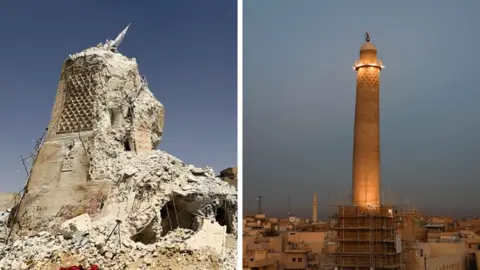 Reuters
ReutersMoszul’s historic buildings, including churches and mosques, reopen again after taking over the takeover of the Iraqi city by taking over by the extreme Islamic State (IS) group.
The project, organized and funded by UNESCO, began a year after it was defeated and removed in 2017 in North Iraq.
UNESCO Director General Audrey Azoulay and Iraqi Prime Minister Mohammed Shia Al-Sudani will be involved on Wednesday to reopen.
The local craftsmen, residents and all religious communities in Mosul will also be there.
In 2014, Mosul, which has been considered a symbol of tolerance and coexistence between tolerance and Iraq’s religious and ethnic communities for centuries, was occupied.
He led the group’s extreme ideology to the city, targeting minorities and killing opponents.
Three years later, an American -backed coalition, with the Iraqi army and state -related militia, triggered an intense ground and air attack to pull the city back from control. The bloodiest battles focused on the old city, where the group warriors took the last job.
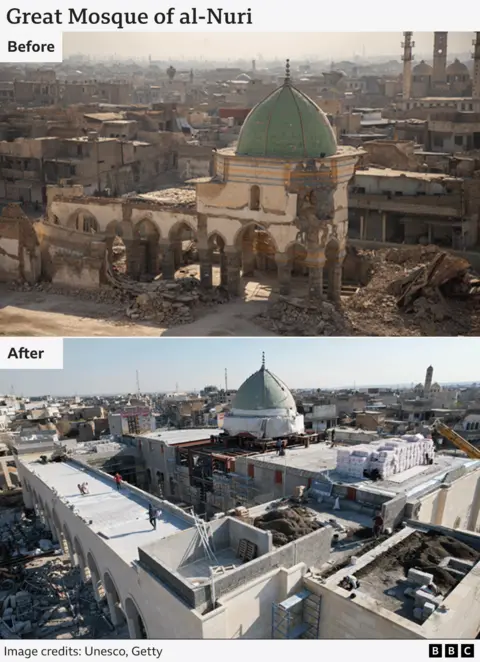
Ali Al-Baroodi, a Mosul photographer, reminds me of the horror that welcomed him when he first entered the area, shortly after the street battle in the summer of 2017.
He saw that the gloriously oblique al-Wadba minaret, the so-called “hunchback”, which for centuries had been Mosul emblematic in ruins.
“It was like a ghost city,” he says. “The bodies around it, the painful scent and the terrible scenes of the city and horizon into the war without Minaret.
“It wasn’t the city we knew – like a metamorphosis – we never thought about the worst nightmares. Then I stopped for a few days. I lost my voice. I lost my thoughts.”
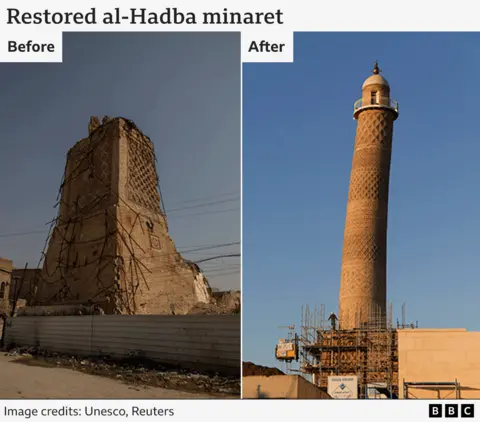
Eighty percent of the city of Moszul on the west coast of the tiger was destroyed during its three -year occupation.
Not only did the repair of churches, mosques and old houses had to be improved, but also the community spirit who had so long lived in relative harmony between religions and ethnic relations.
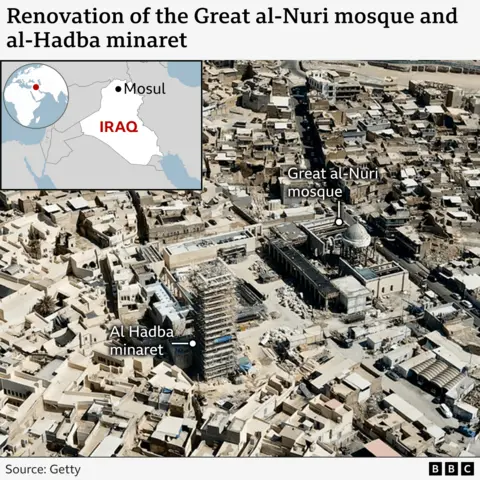
The huge task of rebuilding began under UNESCO’s auspices with a $ 115 million (£ 93 million) budget, which the agency managed to throw, the United Arab Emirates and the European Union.
Father Olivier Poquillon – the Dominican priest – returned to Mosul to help supervise the monastery of one of the most important buildings, Notre -Dame de l’Eure, known as Al -Saa’a, founded nearly 200 years ago –
“First we started to collect the team first – a group consisting of old Mosul people, Christians, Muslims,” he says.
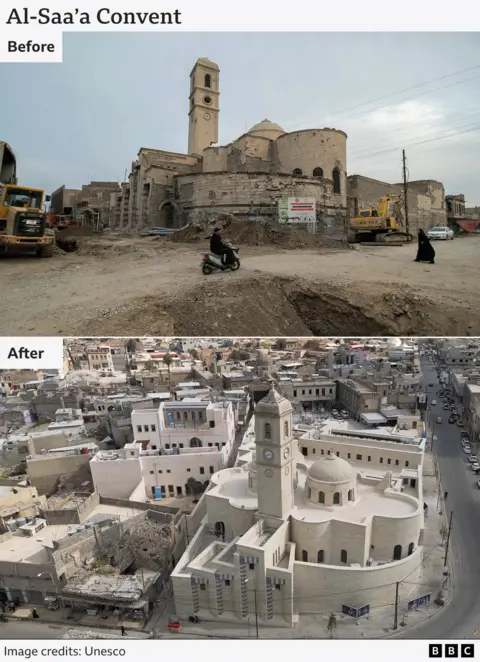
Father Poquillon says that bringing communities was the biggest challenge and the biggest result.
“If you want to rebuild the buildings you can first rebuild trust – if you do not rebuild trust, it is useless to reconstruct the walls of buildings because they become the target of other communities.”
For the complete project, which included the restoration of 124 old houses and two particularly fine castles, the main architect, Maria Rita Acetoso, who came to Mosul from the UNESCO restoration work in Afghanistan.
“This project shows that culture can create jobs, encourage the development of skills, and also feel something meaningful to those involved,” he says.
He hopes that rebuilding can restore hope and allow people to restore people’s cultural identity and memory.
“I think this is particularly important for young generations adults in conflict and political instability,” he added.
According to UNESCO, more than 1,300 local youth were trained with traditional skills while creating about 6,000 new jobs.
More than 100 classrooms have been renovated in Mosul. Thousands of historical fragments have been recovered and cataloged from debris.
Of the engineers involved in the reconstruction, 30% were women.
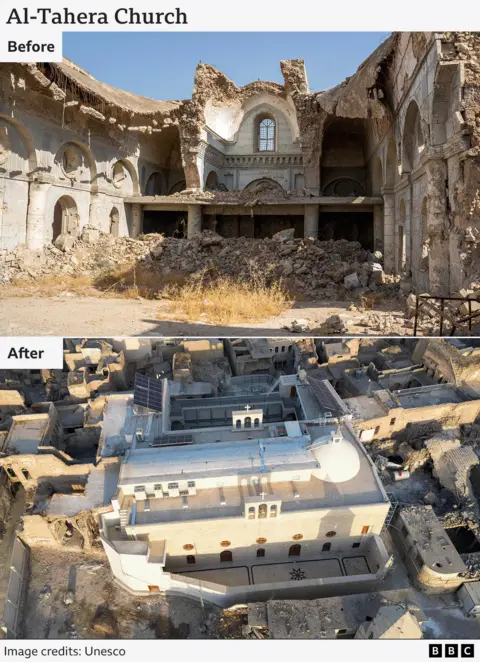
After eight years, the bells ring again in Mosul from the Al-Tahera temple, the roof of which has collapsed after it caused serious damage in 2017.
Further Mosul’s main landmarks were also restored to Al-Had, the Dominican Al-Saa’a Monastery and the Wriggling Minaret of the Al-Nouri Mosque complex.
And people were able to return to the houses that have been handed over to their families for centuries.
One of the residents, Mustafa, said: “My house was built in 1864 – unfortunately it was partially destroyed during the liberation of Mosul and was not sufficient to live there, especially with my children.
“So I decided to move to my parents’ house. I was very happy and excited to see my house rebuild again.”
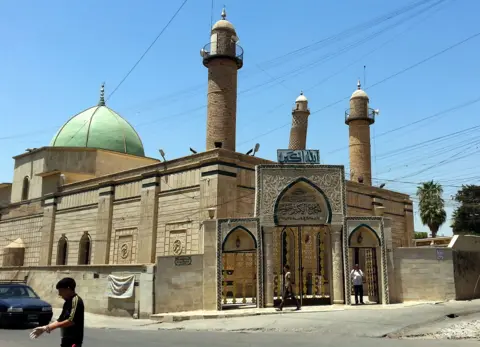 Epic
EpicAbdullah’s family has been living in the house of the Old Town since the 19th century, when the area was the center of wool trade – so he says that their home is so valuable to them.
“After UNESCO rebuilt my house, I returned,” he says. “I can’t describe the feeling because after seeing all the devastation there, I thought I could never get back and live there.”
The scars that Mosul’s men have endured are not yet healing – just like Iraq, remains in the same fragile condition.
But the rebirth of the old city from debris is the hope of a better future – as Ali Al -Baroodi continues to document the development of his beloved home day by day.
“It’s really like a dead person returns to life in a very nice way – this is the true spirit of the city that returns to life,” he says.